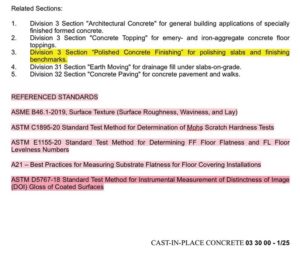Concrete chronicles: Achieving floor flatness and levelness

Figure 2 is an example of an outline spec. Here are some general steps that can help to achieve consistent FF and FL:
Start with a flat, compacted, and level base
Before pouring the concrete, ensure the base on which the slab will be constructed is level and flat. This can be achieved by properly grading and compacting the soil, and using a laser level or other equipment to ensure the base is within the required tolerances.
Use the right mix design and curing techniques
The mix design of the concrete, including the type and amount of cement, aggregate, and water, can affect the flatness and levelness of the finished slab. Moreover, proper curing techniques can help to prevent cracking and warping of the concrete, which can affect its flatness and levelness. The latter is especially true with newer low-carbon mix designs where older methods of curing (i.e. topical spray applications, membranes, etc.) may not cure sufficiently to reduce undulation, curling, and other manifestations of reduced FF and FL. Internally cured concrete (ICC) approaches can dramatically reduce volume change through better curing. Consult with a concrete expert to determine the appropriate mix design and curing methods for a specific project.
Control the placement and finishing process
During the concrete placement and finishing process, it is important to control the rate of placement, use the appropriate tools, and properly consolidate and level the concrete to prevent the formation of air pockets or voids.
The use of a power trowel, laser screed, or other finishing equipment should be carefully controlled to prevent trowel marks or other irregularities that can affect FF and FL. Trowel harmonics, vibrations, and resonances that occur when a power trowel is used to finish new concrete, can play an important part in missing or achieving your benchmarks. Different blades as well as the speed and angle of trowelling will affect the plastic concrete differently.
Perform QC testing
Throughout the construction process, it is important to perform regular QC testing, such as using a laser screed or other equipment to measure FF and FL. This can help to identify and correct any issues that may arise during the construction process, and ensure the finished slab meets the required standards.
By following these steps and working with experienced concrete professionals, it is possible to achieve consistent FF and FL on concrete slabs.

Measuring FF and FL of concrete
FF and FL are measured in accordance with ASTM E1155 for slabs on grade. For elevated slabs, FL is only valid at placement and before shoring is pulled, but the FF factor will remain important. Standardized measurements are employed at regular intervals, uniformly distributed across the test section, properly distanced from slab boundaries, construction joints, and other breaks in plane (e.g. block-outs or penetrations). Testing must be conducted within 72 hours of concrete placement and prior to removal of any shoring to comply with the test standard.
The adoption of the standardization of FF/FL testing in Division 03 allows for uniform testing of concrete slabs during the threshold inspection, delivering results to the architecture and engineering team, showing compliance to or failure in meeting design specification requirements.







